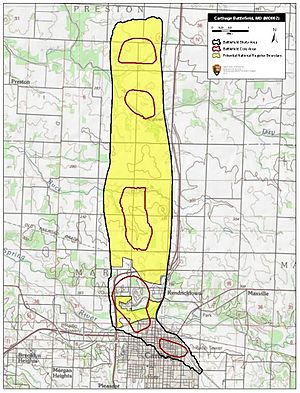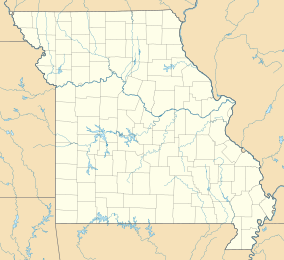Battle of Carthage State Historic Site facts for kids
The Battle of Carthage State Historic Site is a special place in Carthage, Missouri. It's a 7.4-acre (3.0 ha) park that helps us remember an important event from the American Civil War. This site protects one of the spots where the Battle of Carthage happened in 1861. This battle was one of the very first fights of the Civil War. The state of Missouri bought this land in 1990, and it's now looked after by the Missouri Department of Natural Resources.
Quick facts for kids Battle of Carthage State Historic Site |
|
|---|---|

Carthage Battlefield
|
|
| Location | Carthage, Jasper, Missouri, United States |
| Area | 7.4 acres (3.0 ha) |
| Established | 1990 |
| Visitors | 24622 (in 2017) |
| Governing body | Missouri Department of Natural Resources |
| Website | Battle of Carthage State Historic Site |
Contents
What Was the American Civil War?
The American Civil War was a huge conflict in the United States. It lasted from 1861 to 1865. The war was mainly fought between the Union (the northern states) and the Confederacy (the southern states). A big reason for the war was the disagreement over slavery. Southern states wanted to keep slavery, while northern states mostly opposed it.
Missouri was a "border state." This meant it was a slave state but stayed in the Union. Because of this, Missouri became a very important battleground. Both sides wanted control of Missouri.
The Battle of Carthage: An Early Fight
The Battle of Carthage happened on July 5, 1861. It was one of the first major land battles of the Civil War. It took place just a few months after the war officially began. This battle showed how complicated the war would be in Missouri.
Who Fought in Carthage?
On one side was the Missouri State Guard. This group was led by Claiborne Fox Jackson. He was the governor of Missouri at the time. Governor Jackson supported the Confederacy. His forces were mostly made up of volunteers from Missouri. They were not as well-trained or equipped as regular army soldiers.
On the other side were Union forces. These were led by Franz Sigel, a Union colonel. His soldiers were mainly from Missouri and Illinois. They were better trained and had more cannons.
How the Battle Unfolded
The battle started when Colonel Sigel's Union troops tried to stop Governor Jackson's State Guard. Jackson's forces were marching south to meet up with other Confederate troops. Sigel wanted to prevent this.
The fighting began north of Carthage. Sigel's smaller, but better-equipped, force attacked Jackson's much larger group. The battle moved through the day. Jackson's men used their large numbers to surround Sigel's troops.
Sigel's soldiers fought bravely. They used their cannons effectively. However, they were outnumbered. As the day went on, Sigel realized he couldn't win. He decided to retreat.
The Union forces pulled back through the town of Carthage. They continued their retreat south. The Missouri State Guard followed them. The fighting ended as night fell.
Why Was This Battle Important?
Even though it wasn't a huge battle, Carthage was significant for a few reasons:
- First Major Land Battle: It was one of the first big land battles of the Civil War. It showed that the war would be long and difficult.
- Boost for Missouri State Guard: The battle was seen as a victory for the Missouri State Guard. It gave them confidence.
- Missouri's Role: It highlighted Missouri's importance in the war. Both sides fought hard for control of the state.
Visiting the Historic Site Today
The Battle of Carthage State Historic Site helps visitors learn about this early Civil War battle. It's a quiet place where you can imagine what happened there.
- Walking Trails: The site has trails that take you through parts of the battlefield. You can see the landscape where the soldiers fought.
- Information Panels: There are signs and markers that explain the battle. They tell you about the events and the people involved.
- Learning Opportunity: It's a great place to learn about the Civil War. You can understand how important Missouri was during this time.
The site is managed by the Missouri Department of Natural Resources. They work to protect the history of the area. It's a place where you can connect with the past and understand the challenges faced by people during the Civil War.


